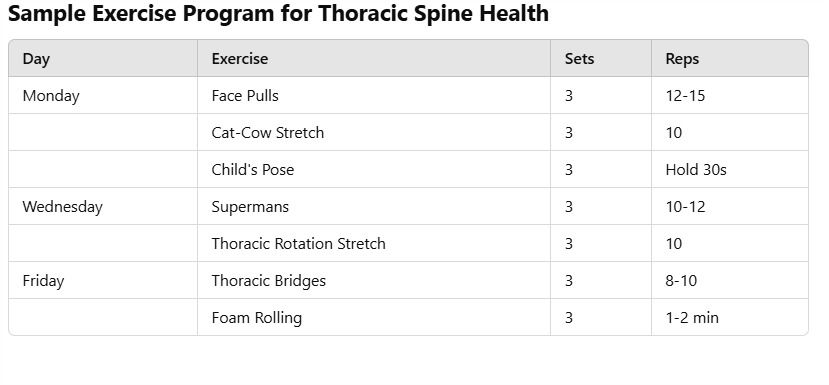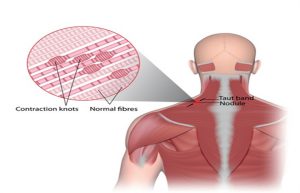Mid-Back Discomfort: Preventative and Therapeutic Tips for Thoracic Spine Pain by Mastering Mid-Back Mobility
Introduction
Mid-back discomfort is a common complaint among individuals of all ages, affecting everyday activities and overall quality of life. The thoracic spine, which comprises the middle segment of your spine, plays a crucial role in stabilizing your upper body, maintaining proper posture, and enabling smooth movements. Unfortunately, pain in this region, also known as thoracic spine pain, can result from various factors, such as poor posture, muscle imbalances, or lack of mobility.
Addressing mid-back discomfort is essential for achieving optimal spine health, back flexibility, and pain relief. This comprehensive guide explores mid-back muscles, thoracic spine pain, and mid-back mobility. It provides practical tips for pain prevention, stretching routines, strengthening exercises, and much more. Whether you are an athlete, an office worker, or someone looking to improve your overall wellness, this article is packed with insights to help you maintain a healthy spine and prevent future issues.
Section 1: Understanding Mid-Back Muscles and Thoracic Spine Pain
The Anatomy of Mid-Back Muscles
The mid-back, or thoracic region, consists of 12 vertebrae (T1-T12) connected to the rib cage. It is supported by a complex network of muscles, including:
- Rhomboids: Located between the shoulder blades, these muscles retract and stabilize the scapula.
- Trapezius (mid and lower fibers): A large muscle that extends from the neck down to the middle of the back, aiding in shoulder movement.
- Latissimus Dorsi: Covers the lower half of the back, playing a key role in shoulder extension, adduction, and internal rotation.
- Erector Spinae: A group of muscles running along the spine, helping with posture and spinal extension.
Understanding the function of these muscles is crucial for addressing pain and enhancing thoracic spine exercises.
Causes of Thoracic Spine Pain
Several factors can contribute to discomfort in the mid-back region:
- Poor Posture: Slouching or prolonged sitting can strain the thoracic muscles, leading to tightness and pain.
- Muscle Imbalances: Weakness in certain muscle groups can cause compensatory overuse of others, resulting in discomfort.
- Lack of Mobility: Reduced flexibility in the thoracic spine can lead to stiffness, impacting overall movement and posture.
- Injuries: Sports-related injuries or sudden trauma can cause mid-back pain, often requiring physical therapy for recovery.
By identifying the root causes, we can explore targeted strategies for back pain relief and mid-back mobility.
Section 2: Prevention Methods
General Prevention Techniques
Preventing thoracic spine pain begins with incorporating healthy habits into your daily routine. Here are some effective methods:
- Ergonomic Workspace Setup: Ensure your chair, desk, and monitor are aligned to promote proper posture.
- Frequent Breaks: Take short breaks every 30-60 minutes to stand, stretch, and move around.
- Mindful Posture: Practice sitting and standing with your shoulders back and core engaged.
- Regular Exercise: Incorporate thoracic spine exercises to maintain strength and flexibility.
- Hydration and Nutrition: Staying hydrated and consuming anti-inflammatory foods can support muscle health.
Section 3: Stretching Exercises for Mid-Back Mobility
Dynamic Stretching
Dynamic stretching involves active movements that gently stretch muscles, improving thoracic mobility and preparing the body for physical activity.
- Cat-Cow Stretch: This stretch improves spinal flexibility and warms up the thoracic region.
- How to do it: Start on all fours, arch your back (cow pose), then round your back (cat pose).
- Thoracic Rotation Stretch: Enhances rotational mobility of the spine.
- How to do it: Sit on the floor with legs crossed, place one hand behind you and gently twist your torso to the opposite side.
Static Stretching
Static stretches are held for longer periods to enhance flexibility and reduce muscle tension.
- Child’s Pose: A yoga pose that stretches the lower and mid-back muscles.
- How to do it: Kneel on the floor, sit back on your heels, and extend your arms forward, lowering your torso.
- Thoracic Extension Stretch: Improves extension of the mid-back.
- How to do it: Sit on a chair, clasp your hands behind your head, and gently lean back, opening up the chest.
Section 4: Strengthening Routines for Thoracic Spine
Importance of Strengthening
Strengthening the mid-back muscles is vital for improving posture, enhancing stability, and preventing pain. Here are some effective exercises:
- Face Pulls: Targets the rhomboids and rear deltoids, improving scapular stability.
- Supermans: Strengthens the erector spinae and promotes thoracic extension.
- Thoracic Bridges: Activates the muscles along the thoracic spine for improved mobility.

Section 5: Warm-Up Techniques for Thoracic Mobility
A proper warm-up prepares the thoracic spine for exercise and reduces the risk of injury. Here are some techniques:
- Foam Rolling: Use a foam roller on the thoracic spine to release tension.
- Arm Circles: Engage the shoulder girdle and activate mid-back muscles.
- Wall Angels: Improve shoulder and thoracic mobility by sliding arms up and down a wall.
Section 6: Injury Prevention and Recovery Strategies
Injury Prevention Tips
- Gradual Progression: Avoid sudden increases in exercise intensity to prevent muscle strain.
- Core Stability: Strengthening the core supports the thoracic spine and reduces injury risk.
- Stretch Regularly: Incorporate daily stretching routines to maintain flexibility.
Recovery Strategies
- Rest and Ice: If you experience mid-back pain, rest the affected area and apply ice to reduce inflammation.
- Heat Therapy: Use a heating pad to relax tight muscles and improve blood flow.
- Physical Therapy: A tailored program from a physiotherapist can accelerate recovery and restore mobility.
Section 7: Advanced Therapeutic Techniques
Physical Therapy
Physical therapy is effective for treating chronic thoracic spine pain through targeted exercises, manual therapy, and corrective movements.
Massage Therapy
Massage can relieve muscle tightness, reduce stress, and enhance blood circulation in the thoracic region.
Kinesiotaping
Kinesiotaping provides support to the muscles without restricting movement, promoting better posture and reducing pain.
Manual Therapies
Techniques like chiropractic adjustments and osteopathic manipulations can realign the spine and improve function.
Dry Needling
Dry needling is an important therapeutic technique because it addresses myofascial pain syndromes by directly targeting trigger points—tight bands of muscle that cause pain and restrict movement. By releasing these tight spots, dry needling can significantly improve muscle function, enhance flexibility, and reduce discomfort, especially in areas like the mid-back where muscle stiffness is common.
Why Is It Important?
- Pain Relief: Dry needling is effective in reducing muscle pain, especially in cases of chronic pain and muscle tightness. It offers a targeted approach to relieve discomfort without the need for medication.
- Improved Range of Motion: Releasing trigger points can increase muscle elasticity, allowing for better movement and flexibility. This is particularly beneficial for athletes and individuals with restricted thoracic mobility.
- Faster Recovery: The technique promotes blood flow and healing in the affected areas, accelerating recovery from muscle injuries or overuse.
- Enhanced Muscle Activation: It helps restore normal muscle function by resetting neuromuscular patterns, thus improving overall muscle coordination and strength.
Muscles Included
Dry needling can be applied to various muscles in the mid-back region, including:
- Rhomboids: These muscles are responsible for retracting the scapula and stabilizing the shoulder blades.
- Trapezius (mid and lower fibers): These help with shoulder movement and support the upper spine.
- Latissimus Dorsi: A large muscle that aids in shoulder and back movement.
- Erector Spinae: These muscles run along the spine and are crucial for maintaining posture and spinal extension.
Techniques Used in Dry Needling
- Superficial Dry Needling: Involves inserting the needle just beneath the skin to stimulate the underlying fascia and muscle tissue.
- Deep Dry Needling: Targets deeper muscle layers to release tight trigger points and alleviate muscle knots.
- Pistoning Technique: The needle is rapidly moved up and down to provoke a twitch response in the muscle, helping to release tension.
- Static Technique: The needle is inserted and held in place for a few minutes to allow the muscle to relax gradually.
- Combined Approach: Often followed by stretching exercises and neuromuscular re-education to optimize the benefits of the dry needling session

Start implementing these tips into your daily routine to experience relief from thoracic spine pain. Share this article with anyone who might benefit, and let’s work together towards a pain-free, healthier life!



